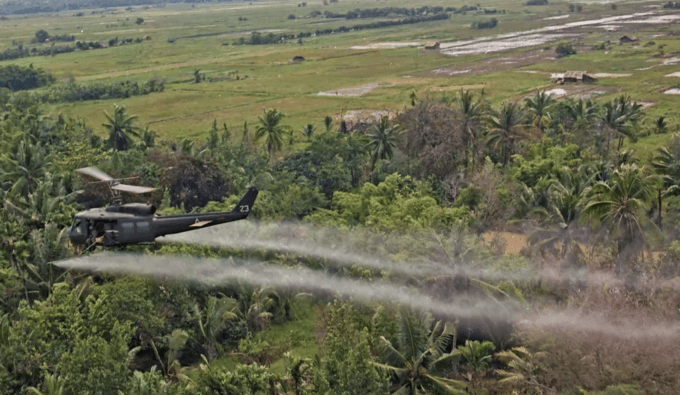Vietnam Chemical Warfare’s Secret Toxic Legacies: Agent Blue

Huey helicopter spraying chemical defoliants in the Mekong Delta of South Vietnam. Photo: National Archives.
For over 50 years, US news about chemical warfare during the American Vietnam War has been dominated by the story of Agent Orange and its devastating impacts.
During the Vietnam War period, however, another diabolical concoction called Agent Blue was also used extensively in Vietnam. This arsenic-based herbicide was used to kill rice and the public knew little about its use. In fact, the first news reference to this chemical weapon was a simple letter to the editor sent by Arthur H. Westing in 1971 and published by the New York Times under the headline “‘Agent Blue’ in Vietnam.”
This blip of attention to tactical herbicide Agent Blue wasn’t followed up until 44 years later, when Loana Hoylman published an article, “Today’s Blue Arsenic in the Environment,” in a 2014 issue of Veteran magazine, published by Vietnam Veterans of America.
Finally, in 2020 Kenneth R. Olson (one of the authors of the article you are reading now) and Larry Cihacek published the first refereed journal article on the topic, “The Fate of Agent Blue, the Arsenic Based Herbicide, Used in South Vietnam during the Vietnam War,” in the Open Journal of Soil Science.
The question remains: How can this secret use of Agent Blue to destroy civilian food (rice) sources and agricultural production sites have gone uncovered by US news organizations for 50 years? It’s an important question. Let’s sketch this hidden chemical warfare and its current impact.
In the beginning, Agent Blue was sprayed by the Republic of Vietnam military for three years before the 1965 official start of the United States’ Vietnam War.
Vietnam War veterans, historians and scholars have collected information on the spraying of Agent Blue on rice paddies and mangrove forests in the Mekong Delta and Central Highlands. by the RV military with the support of the US Army, US Navy and CIA.
The Institute of Medicine estimated that 3.2 million liters (containing 468,000 kilograms of arsenic) were sprayed during the Republic of Vietnam’s Khai Quang (food denial) program.
This was in addition to the US Air Force’s Operation Ranch Hand spraying of Agent Blue primarily from C-123 aircraft. The Operation Ranch Hand missions maintained records of the locations and quantities of herbicides sprayed (over 4,712,000 liters containing 664,392 kilograms of arsenic) from 1961-1971.
The Institute of Medicine estimated that, in total, 7.8 million liters (1,132,400 kilograms of arsenic) of Agent Blue were applied to southern Vietnam landscape from 1962 to 1971. This total includes both the 1962 to 1965 RV Khai Quang program, done by the RV military with the assistance of the CIA, US Army and US Navy, and the part of the total Agent Blue applied by US Air Force Operation Ranch Hand from 1962 to 1971.
This is a mind-boggling amount of highly toxic chemicals to be sprayed over the Mekong Delta’s rice fields, which were a prime rice growing region in Vietnam, for a decade. So, what has happened to all this chemical warfare agent during the last 60 years?
Since this chemical warfare began, the southern Vietnam environment and Vietnamese living in the Mekong Delta have bio-accumulated arsenic from both natural and anthropic sources via their drinking water (groundwater from tube wells) and food supply, which has increased their risk of chronic poisoning over time. Arsenic is water soluble, has no half-life, and is toxic. Put another way, its poison keeps on poisoning forever.
We’ll be publishing a follow-up research paper, “The Secret Toxic Legacies of Chemical Warfare: Agent Blue Use during the 2nd Indochina War and the Vietnam War (1961-1971),” in the November issue of the Open Journal of Soil Science, an open-access publication from Scientific Research Publishing (SCIRP).
The paper’s synthesis and analysis of publications and records will document the contributions of the South Vietnamese government and the United States military to arsenic levels and it will describe arsenic’s present-day persistence in the Vietnam Mekong Delta groundwater.
Here’s a one-sentence preview of the findings: As both the Vietnamese rice farmers and US military personnel who were exposed to Agent Blue can attest, poisoning the water you drink or the local food you eat is not a good idea.
This story was first published by AsiaTimes.
No comments:
Post a Comment